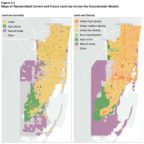
Our goals in this research were to help improve the region’s capacity to adapt to both a changing climate and changes in land use and to better understand the costs of both action and inaction across a wide range of futures. Drawing on experience in Louisiana and other coastal environments, we set out to build a transparent, interactive, and technically credible approach to decision support to assess vulnerabilities and gain insights into the potential strategies to reduce vulnerabilities under a range of climate and land use futures. Our work builds on the strong base of leadership and technical capacity already present in the region.
View this complete post...














 RSS Feed
RSS Feed